The U.S. Navy is paving new paths toward innovation and getting more creative about how it harnesses new talent while developing and retaining its workforce.
Christopher Cleary, principal cyber advisor for the Department of the Navy, said he thinks younger, newer Navy members should be given more responsibility and oversight of long-term initiatives.
“You’ve got to go empower people probably a little further down the food chain and say, ‘I’m empowering you and I’m hoping you stick it out for the next 10 years,’” he said during the Potomac Officers Club’s 2022 Annual Navy Summit.
The Potomac Officers Club’s 2022 Annual Navy Summit is part of its ongoing services-focused series of events. Join POC for its next event in the series, the in-person 2022 Annual Air Force Summit on July 26.
Through this tactic, he explained, these lower ranking service members can “bring consistency of message over a period of time,” and be enabled to see innovation efforts to fruition as they develop their careers and climb the ranks.
Currently, the strategy that’s in place at the Navy places two- and three-star ranking officials at the heads of these projects, but when those officials depart from the service, the efforts are rarely passed on and carried through effectively.
“Those people leave, and then we start all over again for some reason — and that’s very frustrating,” he shared. Being able to rely on service members who have more time left in the Navy to develop and lead these efforts will “begin to solve some of these problems,” Cleary suggested.
Similarly, the Navy’s public-private innovation initiative, NavalX, is seeking out new routes that will enable the service branch to harness ideas, technologies and capabilities developed by a more diverse range of people.
Some of these new tactics will require deliberate cultural shifts if the service is to compete with industry and attract the range of talent it needs, posited Dr. Arielle Miller, technical director and deputy director for NavalX.
“The more we embrace agility, the more we embrace innovation, the more we create a space where people will want to show up because it challenges them and it feeds them,” she commented.
Right now, the Navy, like many military branches and federal agencies, is sometimes hampered by strict bureaucratic processes, procedures and rules. However, Dr. Miller said innovation — especially from academia, industry, small businesses and other environments that aren’t beholden to the same restrictions — doesn’t necessarily have to contradict that.
Dr. Miller explained that innovation challenges the current bureaucratic culture of the Navy “not because there aren’t procedures or ways in which you transition technology from an ideation to out into the fleet or out into the commercial world. Innovation is not chaos.”
“But that culture piece, that mindset piece — that takes more time because that takes trust,” she shared.
Ultimately, although cultural shifts may be tedious and uncomfortable, they are necessary. “Innovation comes from a place of lack and loss,” Dr. Miller said. “It does not come from a place of comfort.”

Hear from Air Force Secretary Frank Kendall and other top Air Force officials during the Potomac Officers Club’s 2022 Air Force Summit on July 26. Register now to save your spot.
















